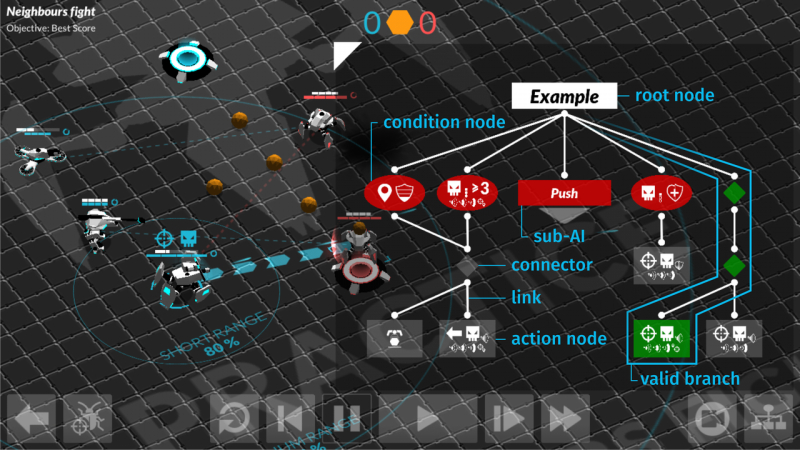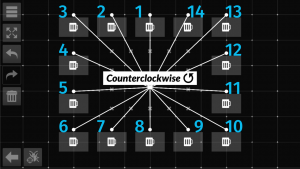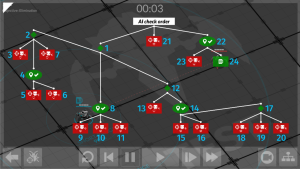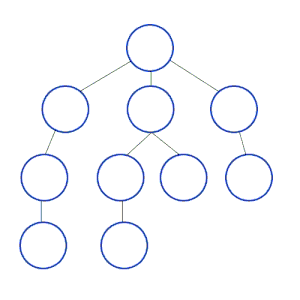Difference between revisions of "BotProgramming Basics"
| Line 49: | Line 49: | ||
== Best practices for AI design == | == Best practices for AI design == | ||
| − | + | Some best coding practices from software development also apply to AIs in ''Gladiabots''. The following rules can help improve the quality of AIs, enhancing both the initial development and subsequent maintenance of the AI. | |
| − | == | + | {{InformationCollapsed|1=Divide and conquer|2=Break down a problem into two or more sub-problems and solve each of them separately. Complex sub-problems can again be divided. In ''Gladiabots'' this could be done by creating sub-AIs for each sub-problem. The complexity is reduced leading to a better maintainability.}} |
| − | == | + | {{InformationCollapsed|1=Readability|2=AIs are written once, but read many times. Overlapping nodes and crossing lines should be avoided.}} |
| − | == | + | {{InformationCollapsed|1=Don't repeat yourself.|2=Avoid using the exact same nodes in several places. Sometimes duplicate nodes can be prevented by using bot specific filters or additional conditions. If its not possible to prevent duplicate nodes in the first place one can try to move them to sub AIs.}} |
<!-- | <!-- | ||
| − | + | ||
| + | > Comment it with empty sub-AIs | ||
| + | |||
| + | |||
| + | Test new code | ||
| + | |||
| + | |||
| + | The size of a project or program has a significant effect on error rates, | ||
| + | |||
| + | How adaptable is the program to cope with changing requirements? | ||
| + | |||
| + | "What happens before one gets to the coding stage is often of crucial importance to the success of the project. | ||
| + | |||
| + | |||
Code conventions improve the readability of the software, allowing engineers to understand new code more quickly and thoroughly. | Code conventions improve the readability of the software, allowing engineers to understand new code more quickly and thoroughly. | ||
| Line 74: | Line 87: | ||
Ever have a group of Nodes that you regularly use, and the same thing is present in your AI again and again? Sub-AIs are used like Macros. You can just make an AI with the commonly used group of Nodes, and then add this as a Sub-AI in your main AI. Sub-AIs tend to improve game performance (more Nodes make the game laggier) | Ever have a group of Nodes that you regularly use, and the same thing is present in your AI again and again? Sub-AIs are used like Macros. You can just make an AI with the commonly used group of Nodes, and then add this as a Sub-AI in your main AI. Sub-AIs tend to improve game performance (more Nodes make the game laggier) | ||
You can also use Sub-AIs to make Hybrids out of existing AIs. Remember, Sub-AIs are essentially AIs linking other AIs. | You can also use Sub-AIs to make Hybrids out of existing AIs. Remember, Sub-AIs are essentially AIs linking other AIs. | ||
| − | + | ||
| − | + | ||
| + | |||
| + | {{Warning|Rest of the page is a work in progress.}} | ||
| + | |||
| + | == Debugging AIs == | ||
| + | |||
| + | == Combining condition nodes == | ||
| + | |||
| + | == Naming AIs == | ||
| + | |||
| + | |||
| + | == Best practices for AI design == | ||
== Debugging AIs == | == Debugging AIs == | ||
Revision as of 16:26, 21 October 2017
| This page needs improvement, you are welcome to contribute. |
Basics
The robots in Gladiabots are autonomous and obey their Artificial Intelligence (AI). Bots can only execute one of the possible actions at a time. The AIs task is to determine what action to use in the current situation. Each bot checks its AI counterclockwise, searching for the first valid branch leading to an action.
The AI of a bot is shaped like an upside down tree. It can be composed of the following elements:
| Element | Description |
|---|---|
| Root node | Each AI contains exactly one root node that defines the starting point of the AI check. Nodes linked from the bottom of the root node are evaluated counterclockwise. The root node indicates the name of the AI. |
| Action node | If a rectangular-shaped action node is evaluated valid during AI check, the described action is executed for the current tick. An action node is considered invalid if the bot cannot perform it . .
|
| Condition node | If an oval-shaped condition node is evaluated valid during AI check, the nodes linked from the bottom of the condition node are evaluated counterclockwise. A condition node is considered invalid if the current situation doesn't fit it . .
|
| Connector node | The diamond-shaped connector node is always evaluated valid during AI check. It connects every node linked to the top of the connector node with every node linked from the bottom of the connector node. A connector node can be used to simplify the layout of the AI. |
| Sub-AI node | One can reuse an AI inside another one, by using a Sub-AI node. When evaluating this node the whole sub-AI is checked for a valid action. A sub-AI can again contain its own sub-AIs. |
| Link | Nodes can be connected with a link. A link is a directed connection from the bottom of one node to the top of another node to the top of another node . .
|
AI checking process
To determine the action a bot should use in the current situation, the valid nodes are traversed by a depth-first search algorithm beginning with the root node:
| Branches are not executed counterclockwise but checked counterclockwise. |
| The evaluation of nodes is instant and is not wasting any time from the current tick. |
Best practices for AI design
Some best coding practices from software development also apply to AIs in Gladiabots. The following rules can help improve the quality of AIs, enhancing both the initial development and subsequent maintenance of the AI.
|
|
|



